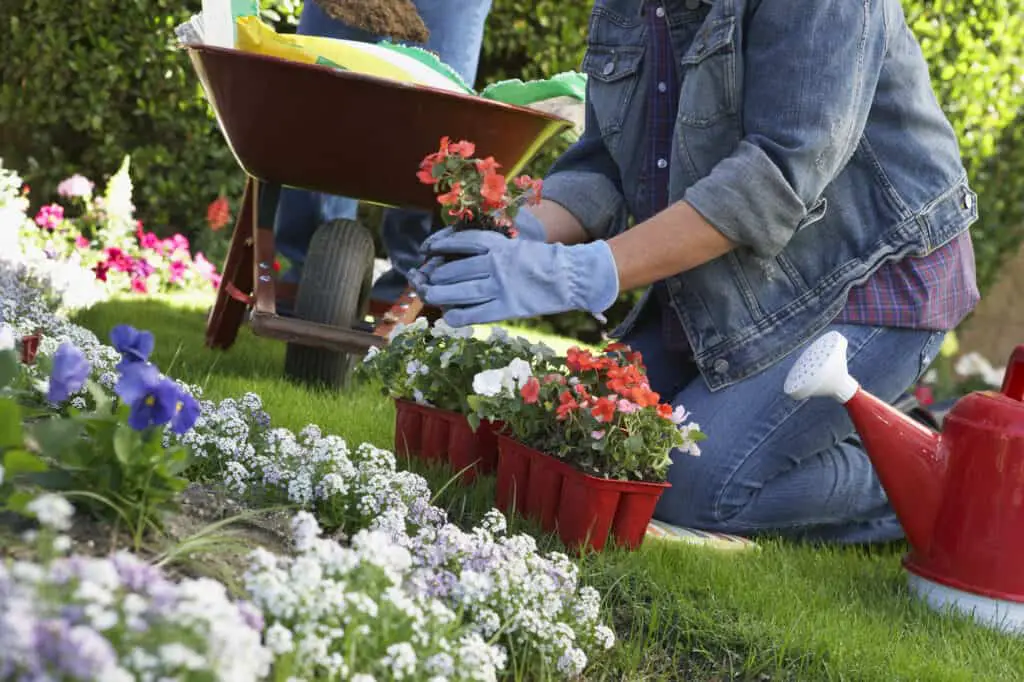Looking to eliminate grass from mulch? There are physical and chemical treatments available that can create practical barriers or use herbicides around your plants.
Mulch is a material used as a soil covering. It helps to keep the soil cool, suppress weed growth, and retain moisture.
Mulch also adds to the beauty of your home exterior, looking at a professionally maintained landscape.
Mulch can also help reduce weed spread, but it may need help from soil coverings and/or herbicides.
How do you eliminate grass from mulch?
Fortunately, there are several methods to keep your mulch free of grass. Some are temporary, while others are permanent solutions.
Simple ingredients from your kitchen can be used for some methods, while others require garden tools and some physical effort.
Continue reading to find some of the most effective methods we have seen.

Related Reading: Does Pressure Washing With Bleach Harm Your Grass: Expert Insights
Table of Contents
1. Cut Gaps to Eliminate Grass from Mulch
Let’s face it, grass doesn’t just magically appear. The grass in your mulch is likely creeping over from your lawn.
Many people have this problem because the gap between the grass and the mulch isn’t wide enough to prevent grass from infiltrating the mulch.
For a permanent solution, create gaps between the lawn and mulch bed to prevent grassroots from growing in.
You need just enough distance to make it more challenging for grass or weeds to spread onto the mulch.
This can be a border, edge, or pathway, depending on the garden’s shape. Ensure the border is consistent for curved gardens.
2. String Trimmer
This equipment easily cuts unwanted weeds and can reach underplanted ones. With some maneuvering, you can get the hang of trimming the area with precision.
Depending on the severity of your problem and the amount of effort you’re willing to put in, this may be a temporary fix.
Consistent inspection and maintenance will be necessary for this solution to eliminate grass from mulch successfully.
If you don’t mind a little outdoor activity, keeping up on weed and grass growth can be satisfying.
3. Landscaping Fabric
This is a more permanent solution that is generally straightforward to eliminate grass from mulch but needs to be in place before adding the mulch.
The way it works is that you cover the soil with landscaping fabric and then add the mulch.
No grass can grow through landscaping fabric, blocking sun rays from reaching the soil.
I prefer this method since you have to distribute the mulch anyway, so why not put down the fabric offering a more permanent solution?
You have to remember the fabric is in place should you decide to use a trimmer. Cutting into the mulch may cause the fabric to tear.
This fabric is widely available at most plant stores and is a long-term solution once in place.
Although it requires significant effort, completing the task will avoid the hassle of dealing with unwanted weeds every few months.
I placed this fabric before spreading the mulch and can say it works well. You may have the occasional weed or grass pop up, but it is easily managed.
4. Newspaper
This solution to eliminate grass from mulch is similar to the landscaping fabric in that it creates a barrier so the grass cannot grow.
However, as you may have figured out, placing it over the soil and under the mulch will end up with very soggy paper eventually.
The soggy newspaper will degrade, leaving less of a barrier to stop grass and weeds from penetrating the mulch. This is not the most effective way to eliminate grass from mulch.
Instead of exposing the mulch, cover it with newspaper to prevent sunlight from reaching it and prohibit grass growth.
You will have to judge when to remove the newspaper as it will take away from the clean mulch look should you have guests over or the paper becomes soggy from the rain.
This solution is recommended for temporary landscaping and is best done in summer when there’s more sun and less rain rather than in winter when the sun is weaker, and rain is more frequent.
5. Commercial Chemical Herbicide
Perhaps physical solutions haven’t worked for you – maybe you don’t want to spend hours digging or covering the soil. If so, chemistry has the answer.
Naturally, commercial herbicides can eliminate any unwanted weeds, including grass.
Glyphosate is a powerful herbicide that can kill many plants, including woody plants, broadleaf plants, and grasses.
Glyphosate can be effective, but be careful during application to avoid killing unintended plants.
I have sprayed too liberally in the past, killing more than the weeds and unwanted grass.
Use a spray bottle and aim precisely.
6. Vinegar Soap Solution
If you don’t want to use harsh chemicals, vinegar is a safe and natural alternative many people already have at home.
The method involves mixing vinegar and dish soap in a spray bottle, which can be used to spray on any unwanted grass in your mulch.
The acidic vinegar lowers the soil’s pH level, making it difficult for plants to grow. Remember to be precise in spraying not to harm nearby shrubs inadvertently.
Related Reading: Is Pool Water Safe on Grass?
Conclusion
Fortunately, there are physical and chemical solutions to prevent grass from filling up your mulch garden after spending so much time layering and tending it.
To prevent unwanted plants, you can create a gap between the mulch and grass or use a physical barrier above/below the mulch.
There is a range of chemicals available for use, with glyphosate being the harshest and vinegar and soap being softer options that are equally effective.
With some planning and effort, you can maintain the beauty of your home by keeping unwanted weeds and grass at bay.
